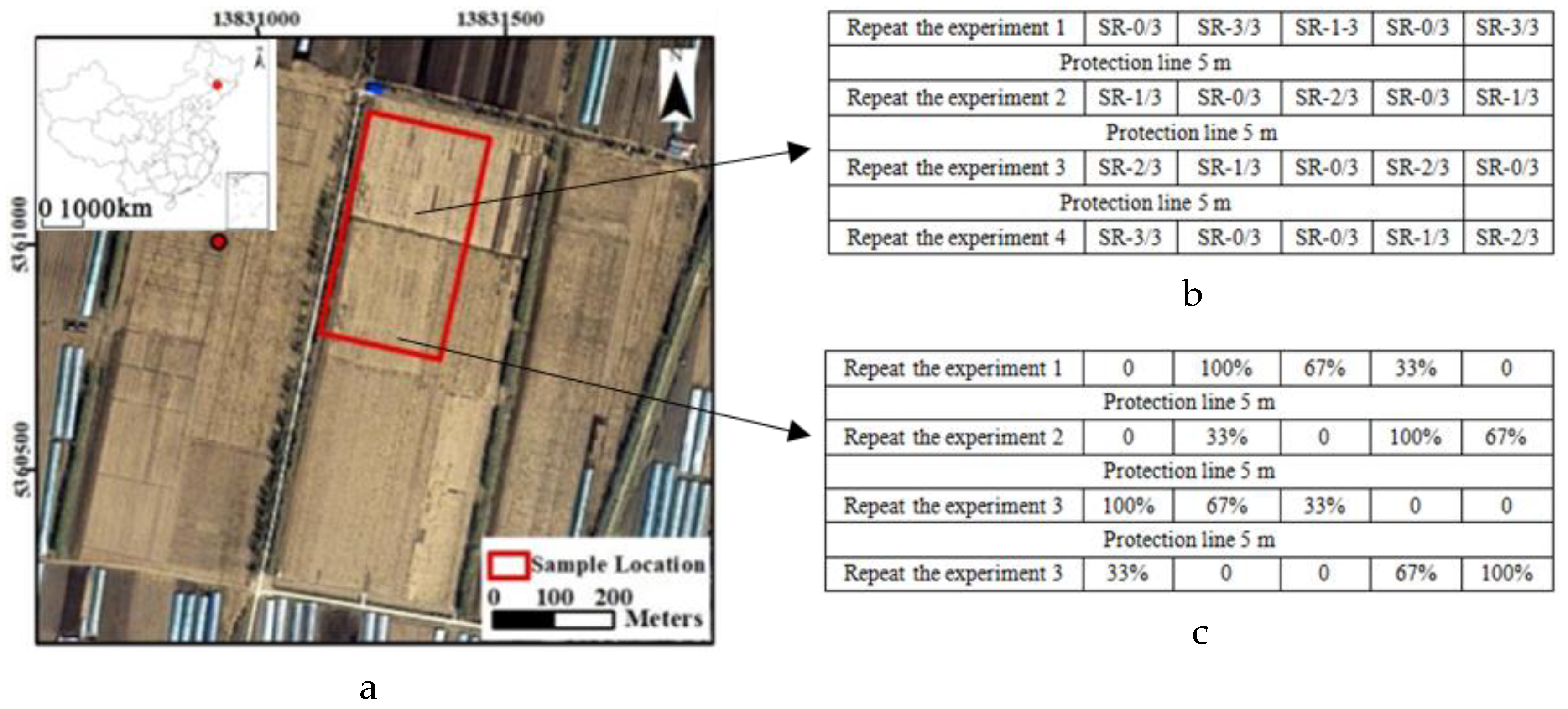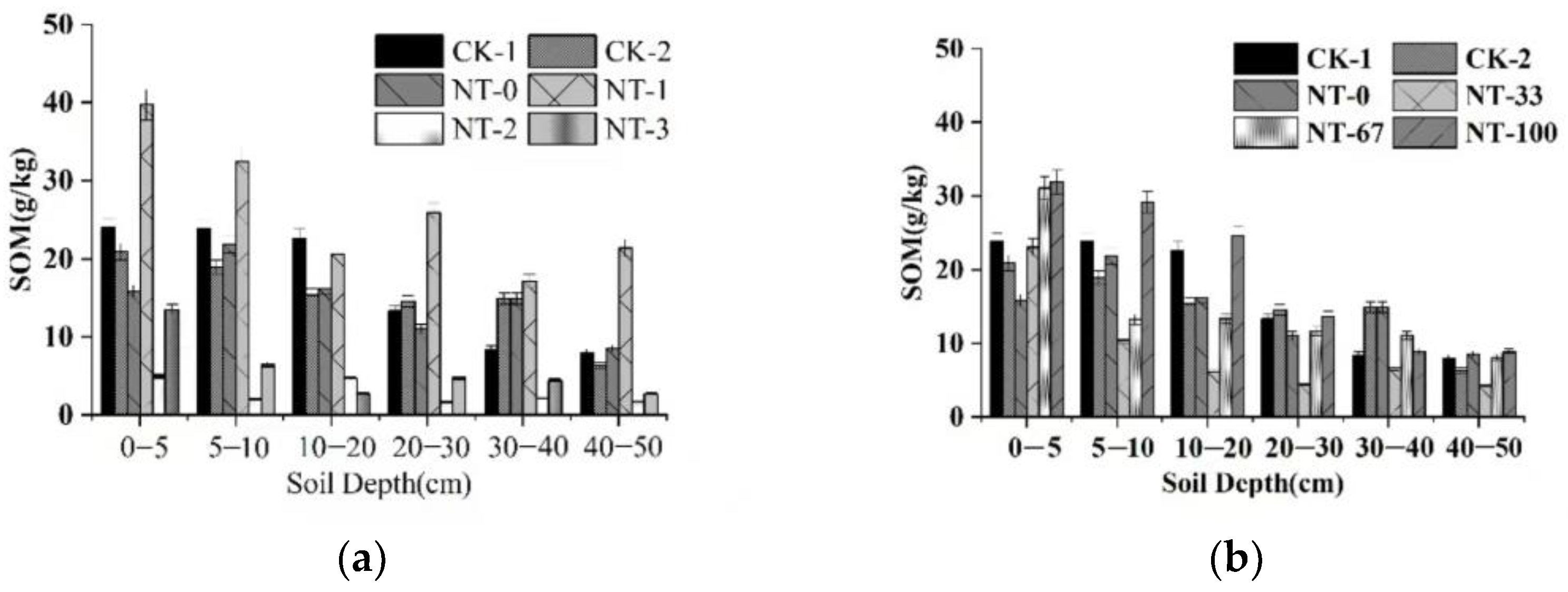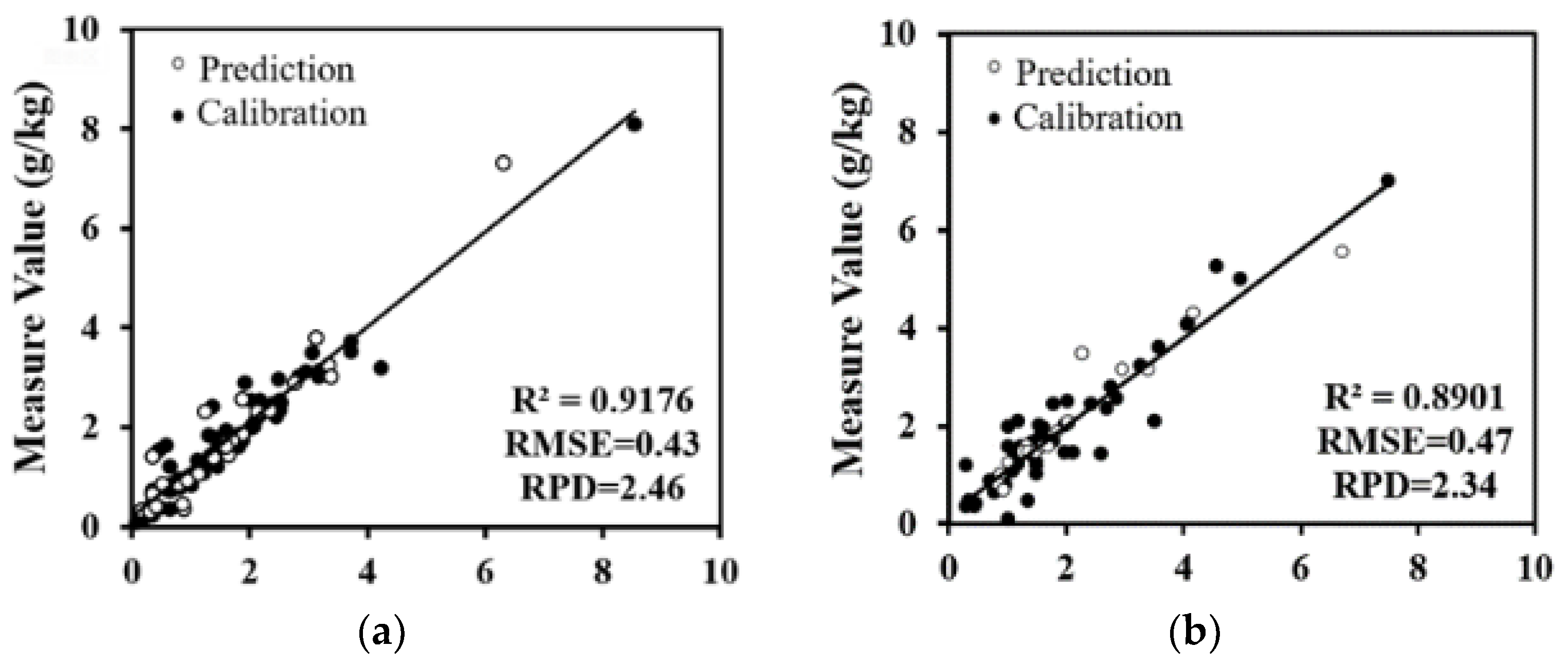Remote Sensing Inversion of Soil Organic Matter Content in Straw-Returned Fields in China’s Black Soil Region
Abstract
1. Introduction
2. Materials and Methods
2.1. Study Area
2.2. Experimental Design
2.3. Sample Handling
2.4. Research Methodology
3. Results
3.1. Soil Spectral Characteristics of Straw-Returned Land in Black Soil Areas
3.2. The Effect of Straw Return on SOM Content in Black Soil Areas
3.3. Assessment of Model Accuracy
4. Discussion
4.1. Impact of Straw Return on SOM in Black Soil Areas
4.2. Evaluation of the PLSR Model
5. Conclusions
Author Contributions
Funding
Institutional Review Board Statement
Informed Consent Statement
Data Availability Statement
Conflicts of Interest
References
- Cui, H.; Luo, Y.; Li, C.; Chang, Y.; Jin, M.; Li, Y.; Wang, Z. Improving Soil Fertility and Wheat Yield by Tillage and Nitrogen Management in Winter Wheat–Summer Maize Cropping System. Agronomy 2023, 13, 740. [Google Scholar] [CrossRef]
- Zhao, Z.; Mao, Y.; Gao, S.; Lu, C.; Pan, C.; Li, X. Organic carbon accumulation and aggregate formation in soils under organic and inorganic fertilizer management practices in a rice–wheat cropping system. Sci. Rep. 2023, 13, 3665. [Google Scholar] [CrossRef] [PubMed]
- Wang, J.Z.; Wang, X.J.; Xu, M.G.; Gu, F.; Zhang, W.J.; Liu, C.A. Crop yield and soil organic matter after long-term straw return to soil in China. Nutr. Cycl. Agroecosys. 2015, 102, 371–381. [Google Scholar] [CrossRef]
- Zhao, Y.; Wang, M.; Hu, S.; Zhang, X.; Ouyang, Z.; Zhang, G.; Huang, B.; Zhao, S.; Wu, J.; Xie, D. Economics-and policy-driven organic carbon input enhancement dominates soil organic carbon accumulation in Chinese croplands. Proc. Natl. Acad. Sci. USA 2018, 115, 4045–4050. [Google Scholar] [CrossRef] [PubMed]
- Behrens, T.; Rossel, R.A.V.; Ramirez-Lopez, L.; Baumann, P. Soil spectroscopy with the Gaussian pyramid scale space. Geoderma 2022, 426, 116095. [Google Scholar] [CrossRef]
- Lavallee, J.M.; Soong, J.L.; Cotrufo, M.F. Conceptualizing soil organic matter into particulate and mineral-associated forms to address global change in the 21st century. Glob. Chang. Biol. 2020, 26, 261–273. [Google Scholar] [CrossRef] [PubMed]
- Ondrasek, G.; Begić, H.B.; Zovko, M.; Filipović, L.; Meriño-Gergichevich, C.; Savić, R.; Rengel, Z. Biogeochemistry of soil organic matter in agroecosystems & environmental implications. Sci. Total Environ. 2019, 658, 1559–1573. [Google Scholar]
- Luce, M.S.; Ziadi, N.; Rossel, R.A.V. GLOBAL-LOCAL: A new approach for local predictions of soil organic carbon content using large soil spectral libraries. Geoderma 2022, 425, 116048. [Google Scholar] [CrossRef]
- Tesfahunegn, G.B.; Tamene, L.; Vlek, P.L.G. Catchment-scale spatial variability of soil properties and implications on site-specific soil management in northern Ethiopia. Soil Till. Res. 2011, 117, 124–139. [Google Scholar] [CrossRef]
- Vaudour, E.; Gomez, C.; Lagacherie, P.; Loiseau, T.; Baghdadi, N.; Urbina-Salazar, D.; Loubet, B.; Arrouays, D. Temporal mosaicking approaches of Sentinel-2 images for extending topsoil organic carbon content mapping in croplands. Int. J. Appl. Earch Obs. Geoinf. 2021, 96, 102277. [Google Scholar] [CrossRef]
- Mirzaee, S.; Ghorbani-Dashtaki, S.; Mohammadi, J.; Asadi, H.; Asadzadeh, F. Spatial variability of soil organic matter using remote sensing data. Catena 2016, 145, 118–127. [Google Scholar] [CrossRef]
- Pittelkow, C.M.; Liang, X.; Linquist, B.A.; van Groenigen, K.J.; Lee, J.; Lundy, M.E.; van Gestel, N.; Six, J.; Venterea, R.T.; van Kessel, C. Productivity limits and potentials of the principles of conservation agriculture. Nature 2014, 517, 365–368. [Google Scholar] [CrossRef]
- Luo, M.; Liu, Y.; Li, J.; Gao, T.F.; Wu, S.; Wu, L.; Lai, X.J.; Xu, H.J.; Hu, H.X.; Ma, Y.H. Effects of Straw Returning and New Fertilizer Substitution on Rice Growth, Yield, and Soil Properties in the Chaohu Lake Region of China. Plants 2024, 13, 444. [Google Scholar] [CrossRef] [PubMed]
- Soriano-Disla, J.M.; Janik, L.J.; Viscarra Rossel, R.A.; Macdonald, L.M.; Mclaughlin, M.J. The performance of visible, near-, and mid-infrared reflectance spectroscopy for prediction of soil physical chemical, and biological properties. Appl. Spectrosc. Rev. 2014, 49, 139–186. [Google Scholar] [CrossRef]
- Guo, J.; Long, L.H.L.; He, J.; Mei, X.; Yang, G.J. Predicting soil organic matter contents in cultivated land using Google Earth Engine and machine learning. Trans. Chin. Soc. Agric. Eng. 2022, 38, 130–137. [Google Scholar] [CrossRef]
- Shi, T.Z.; Chen, Y.Y.; Liu, H.Z.; Wang, J.J.; Wu, G.F. Soil organic carbon content estimation with laboratory-based visible-near-infrared reflectance spectroscopy: Feature selection. Appl. Spectrosc. 2014, 68, 831–837. [Google Scholar] [CrossRef] [PubMed]
- Sewpersad, T.; Xulu, S.; Gebreslasie, M. The assessment of soil organic matter in the KwaZulu-natal province of South Africa and its relationship to spectroscopy data. Geocarto Int. 2024, 39, 2361702. [Google Scholar] [CrossRef]
- Sun, W.; Liu, S.; Zhang, X.; Li, Y. Estimation of soil organic matter content using selected spectral subset of hyperspectral data. Geoderma 2022, 409, 115653. [Google Scholar] [CrossRef]
- Shen, L.Z.; Gao, M.F.; Yan, J.W.; Li, Z.L.; Leng, P.; Yang, Q.; Duan, S.B. Hyperspectral Estimation of SOM Content using Different Spectral Preprocessing Techniques and PLSR Method. Remote Sens. 2020, 12, 1206. [Google Scholar] [CrossRef]
- Wang, X.M.; Yang, C.; Zhou, M.J. Partial Least Squares Improved Multivariate Adaptive Regression Splines for Visible and Near-Infrared-Based Soil Organic Matter Estimation Considering Spatial Heterogeneity. Appl. Sci. 2021, 11, 566. [Google Scholar] [CrossRef]
- Lees, K.J.; Quaife, T.; Artz, R.R.E.; Khomik, M.; Clark, J.M. Potential for using remote sensing to estimate carbon fluxes across northern peatlands—A review. Sci. Total Environ. 2018, 615, 857–874. [Google Scholar] [CrossRef]
- Lyu, F.Z.; Yang, Y.L.; Bao, X.L.; Zhang, C.R.; Zheng, T.T.; He, H.B.; Zhang, X.D.; Xie, H.T. Effects of no-tillage and different stover mulching amounts on soil microbial community and microbial residue in the Mollisols of China. Chin. J. Appl. Ecol. 2023, 34, 903–912. [Google Scholar] [CrossRef]
- Novacoski, E.J.; Caetano, I.K.; Melquiades, F.L.; Aline, M.G.; Torres, Y.R.; Gonzalez-Borrero, P.P. Spectroscopic based partial least-squares models to estimate soil features. Microchem. J. 2022, 180, 107617. [Google Scholar] [CrossRef]
- Yan, X.B.; Wang, Y.X.; Zhang, X.; Wang, Z.G.; Yang, S.; Li, Y.; Wang, C. Performance of preprocessing and multivariate methods in hyperspectral estimation of soil water content. Appl. Ecol. Environ. Res. 2022, 20, 2717–2732. [Google Scholar] [CrossRef]
- Yan, Y.; Ji, W.J.; Li, B.G.; Wang, G.M.; Hu, B.F.; Zhang, C.; Mouazen, A.M. Effects of Long-Term Straw Return and Environmental Factors on the Spatiotemporal Variability of Soil Organic Matter in the Black Soil Region: A Case Study. Agronomy 2022, 12, 2532. [Google Scholar] [CrossRef]
- Zhou, P.; Yang, W.; Li, M.; Wang, W. A New Coupled Elimination Method of Soil Moisture and Particle Size Interferences on Predicting Soil Total Nitrogen Concentration through Discrete NIR Spectral Band Data. Remote Sens. 2021, 13, 762. [Google Scholar] [CrossRef]
- Zhao, R.; Cui, X.M.; Liu, C. Inversion estimation of soil organic matter content based on GF-5 hyperspectral remote sensing image. China Environ. Sci. 2020, 40, 3539–3545. [Google Scholar] [CrossRef]
- Ben-Dor, E.; Chabrillat, S.; Demattê, J.A.M.; Taylor, G.R.; Hill, J.; Whiting, M.L.; Sommer, S. Using Imaging Spectroscopy to study soil properties. Remote Sens. Environ. 2008, 113, 38–55. [Google Scholar] [CrossRef]
- Tan, Y.; Jiang, Q.; Yu, L.; Liu, H.; Zhang, B. Reducing the Moisture Effect and Improving the Prediction of Soil Organic Matter with VIS-NIR Spectroscopy in Black Soil Area. IEEE Access 2021, 9, 5895–5905. [Google Scholar] [CrossRef]
- Ward, K.J.; Chabrillat, S.; Brell, M.; Castaldi, F.; Spengler, D.; Foerster, S. Mapping soil organic carbon for airborne and simulated EnMAP imagery using the LUCAS soil database and a local PLSR. Remote Sens. 2020, 12, 3451. [Google Scholar] [CrossRef]
- Reis, A.S.; Rodrigues, M.; Dos Santos, G.L.A.A.; de Oliveira, K.M.; Furlanetto, R.H.; Crusiol, L.G.T.; Nanni, M.R. Detection of soil organic matter using hyperspectral imaging sensor combined with multivariate regression modeling procedures. Remote Sens. 2021, 22, 100492. [Google Scholar] [CrossRef]
- de Santana, F.B.; de Giuseppe, L.O.; de Souza, A.M.; Poppi, R.J. Removing the moisture effect in soil organic matter determination using NIR spectroscopy and PLSR with external parameter orthogonalization. Microchem. J. 2019, 145, 1094–1101. [Google Scholar] [CrossRef]
- Gu, X.; Wang, Y.; Sun, Q.; Yang, G.; Zhang, C. Hyperspectral inversion of soil organic matter content in cultivated land based on wavelet transform. Comput. Electron. Agric. 2019, 167, 105053. [Google Scholar] [CrossRef]
- Liao, Q.; Gu, X.; Li, C.; Chen, L.; Huang, W.; Du, S.; Fu, Y.; Wang, J. Estimation of fluvo-aquic SOM content from hyperspectral based on continuous wavelet transformation. Trans. Chin. Soc. Agric. Eng. 2012, 28, 132–139. [Google Scholar]
- Zheng, L.; Wu, W.; Wei, Y.; Hu, K. Effects of straw return and regional factors on spatio-temporal variability of soil organic matter in a high-yielding area of northern China. Soil Till. Res. 2015, 145, 78–86. [Google Scholar] [CrossRef]
- Zhu, C.C.; Zhong, W.H.; Han, C.; Deng, H.; Jiang, Y.B. Driving factors of soil organic carbon sequestration under straw returning across China’s uplands. J. Environ. 2023, 335, 117590. [Google Scholar] [CrossRef]
- Guo, L.L.; Nie, Z.Y.; Zhou, j.; An, F.H.; Zhang, L.; Zhang, S.X.; Tóth, T.; Yang, F.; Wang, Z.C. Effects of organic amendments on soil bacterial community structure and yield in a saline-sodic soil cropped with rice. Land Degrad. Dev. 2023, 34, 5514–5527. [Google Scholar] [CrossRef]
- Phiwdaeng, N.; Polpinit, P.; Poltanee, A.; Kaewpradit, W. Land use change from paddy rice to sugarcane under long-term no-till conditions: Increase P balance, soil organic matter and sugarcane productivity. Arch. Agron. Soil Sci. 2024, 70, 1–17. [Google Scholar] [CrossRef]
- Fan, M.; Lal, R.; Zhang, H.; Margenot, A.J.; Wu, J.; Wu, P.; Zhang, L.; Yao, J.; Chen, F.; Gao, C. Variability and determinants of soil organic matter under different land uses and soil types in eastern China. Soil Till. Res. 2020, 198, 104544. [Google Scholar] [CrossRef]
- Wang, Q.; Li, P.; Chen, X. Modeling salinity effects on soil reflectance under various moisture conditions and its inverse application: A laboratory experiment. Geoderma 2012, 170, 103–111. [Google Scholar] [CrossRef]
- Hermansen, C.; Knadel, M.; Moldrun, P.; Grebe, M.H.; Karup, D.; de Jonge, L.W. Complete Soil Texture is Accurately Predicted by Visible Near-Infrared Spectroscopy. Soil Sci. Soc. Am. J. 2017, 81, 758–769. [Google Scholar] [CrossRef]
- Wan, S.M.; Hou, J.Q.; Zhao, J.S.; Claeke, N.; Kempenaar, C.; Chen, X.L. Predicting Soil Organic Matter, Available Nitrogen, Available Phosphorus and Available Potassium in a Black Soil Using a Nearby Hyperspectral Sensor System. Sensors 2024, 24, 2784. [Google Scholar] [CrossRef] [PubMed]
- Rossel, R.A.V.; Walvoort, D.J.J.; McBratney, A.B.; Janik, L.J.; Skjemstad, J.O. Visible, near infrared, mid infrared or combined diffuse reflectance spectroscopy for simultaneous assessment of various soil properties. Geoderma 2006, 131, 59–75. [Google Scholar] [CrossRef]
- Hong, Y.S.; Chen, S.C.; Liu, Y.L.; Zhang, Y.; Yu, L.; Chen, Y.Y.; Liu, Y.F.; Cheng, H.; Liu, Y. Combination of fractional order derivative and memory-based learning algorithm to improve the estimation accuracy of soil organic matter by visible and near-infrared spectroscopy. Catena 2019, 174, 104–116. [Google Scholar] [CrossRef]
- Wang, J.Z.; Tiyip, T.; Ding, J.L.; Zhang, D.; Liu, W.; Wang, F. Quantitative estimation of organic matter content in arid soil using Vis-NIR spectroscopy preprocessed by fractional derivative. J. Spectrosc. 2017, 2017, 1375158. [Google Scholar] [CrossRef]




Disclaimer/Publisher’s Note: The statements, opinions and data contained in all publications are solely those of the individual author(s) and contributor(s) and not of MDPI and/or the editor(s). MDPI and/or the editor(s) disclaim responsibility for any injury to people or property resulting from any ideas, methods, instructions or products referred to in the content. |
© 2024 by the authors. Licensee MDPI, Basel, Switzerland. This article is an open access article distributed under the terms and conditions of the Creative Commons Attribution (CC BY) license (https://creativecommons.org/licenses/by/4.0/).
Share and Cite
Qv, W.; Du, H.; Wang, X. Remote Sensing Inversion of Soil Organic Matter Content in Straw-Returned Fields in China’s Black Soil Region. Sustainability 2024, 16, 7058. https://doi.org/10.3390/su16167058
Qv W, Du H, Wang X. Remote Sensing Inversion of Soil Organic Matter Content in Straw-Returned Fields in China’s Black Soil Region. Sustainability. 2024; 16(16):7058. https://doi.org/10.3390/su16167058
Chicago/Turabian StyleQv, Wei, Huishi Du, and Xiao Wang. 2024. "Remote Sensing Inversion of Soil Organic Matter Content in Straw-Returned Fields in China’s Black Soil Region" Sustainability 16, no. 16: 7058. https://doi.org/10.3390/su16167058
APA StyleQv, W., Du, H., & Wang, X. (2024). Remote Sensing Inversion of Soil Organic Matter Content in Straw-Returned Fields in China’s Black Soil Region. Sustainability, 16(16), 7058. https://doi.org/10.3390/su16167058





